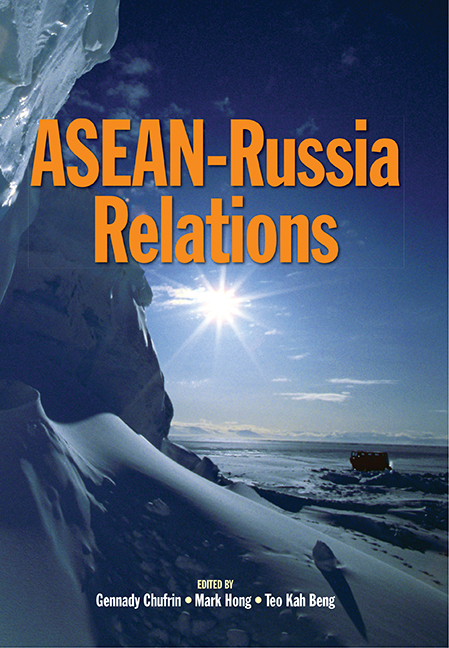Book contents
- Frontmatter
- Contents
- Foreword
- Foreword
- Opening Address
- Opening Address
- The Contributors
- Part I Overview of ASEAN-Russia Relations
- Part II Bilateral Relations
- Part III Security Issues in Southeast Asia
- Part IV Bilateral Economic Relations
- 8 Singapore-Russia Economic Relations
- 9 Russia-Singapore Relations: Thirty-seven Years of Cooperation and Dialogue
- 10 Rationale for a Free Trade Agreement between Russia and Singapore and Russia-ASEAN
- 11 Russia-ASEAN: Problems and Prospects of Economic Cooperation
- Index
11 - Russia-ASEAN: Problems and Prospects of Economic Cooperation
from Part IV - Bilateral Economic Relations
Published online by Cambridge University Press: 09 November 2017
- Frontmatter
- Contents
- Foreword
- Foreword
- Opening Address
- Opening Address
- The Contributors
- Part I Overview of ASEAN-Russia Relations
- Part II Bilateral Relations
- Part III Security Issues in Southeast Asia
- Part IV Bilateral Economic Relations
- 8 Singapore-Russia Economic Relations
- 9 Russia-Singapore Relations: Thirty-seven Years of Cooperation and Dialogue
- 10 Rationale for a Free Trade Agreement between Russia and Singapore and Russia-ASEAN
- 11 Russia-ASEAN: Problems and Prospects of Economic Cooperation
- Index
Summary
To assess the prospects of economic cooperation between Russia and ASEAN, it is necessary first of all to look at the current state of economic interaction between Russia and individual members of ASEAN as well as between Russia and ASEAN as an economic entity. Even after a quick glance, it is easy to see that since the beginning of the 1990s Russia and ASEAN have, in general, developed their political dialogue and political relations quite successfully. On the other hand, the achieved level of Russia's bilateral economic ties with the leading members of ASEAN and consequently with ASEAN as a sub- regional group cannot be described as satisfactory, to put it mildly.
It is natural that Russia's economic relations with various members of ASEAN differ taking into account the history of Southeast Asia during several decades of the Cold War when the region was divided into two blocks along ideological lines. Consequences of that division are still felt in political and economic ties between Russia and ASEAN member-states. In particular it has affected economic exchanges or limited the development of interaction between Russia and some of the founding members of ASEAN.
TRADE
Volume of trade is the most obvious indicator of the current state of economic relations between Russia and ASEAN. Tables 11.1–11.3 clearly show that ASEAN occupies a very low place in Russia's foreign trade, be it in its export or in its import. Since a fall in the Russia-ASEAN trade as a result of the 1998 East Asian financial crisis and a similar one in Russia, there has been a recovery in bilateral trade but its significance is still very low for both sides. There are no members of ASEAN among main Russian trading partners and vice versa —Russia is not a main source of any imports for ASEAN countries nor is it a significant export market for goods made in Southeast Asia.
- Type
- Chapter
- Information
- ASEAN-Russia Relations , pp. 75 - 84Publisher: ISEAS–Yusof Ishak InstitutePrint publication year: 2006



